Co-creating the Rail Corridor's Future
ETHOS Issue 19, Jul 2018

The Rail Corridor refers to the former railway line that stretches from the north to the south of Singapore. Previously known as the Keretapi Tanah Melayu (KTM) Railway Line, it connected Singapore with Malaysia at the northernmost; at the southernmost was the terminus at the Tanjong Pagar Railway Station, located at the edge of Singapore’s Central Business District.
On 30 June 2011, the last train to Malaysia left Tanjong Pagar and the land occupied by the KTM Line reverted to the Singapore government on 1 July 2011. The Tanjong Pagar station building is now gazetted as a National Monument.
Most of the tracks, sleepers and railway equipment along the former railway line have been removed as part of the land return agreement. The Rail Corridor has become a swath of wilderness landscape and an informal public space. Popularly called the “green corridor”, it stands out in contrast to the dense urban environment found in most parts of the island.

A Special Corridor with Immense Opportunities
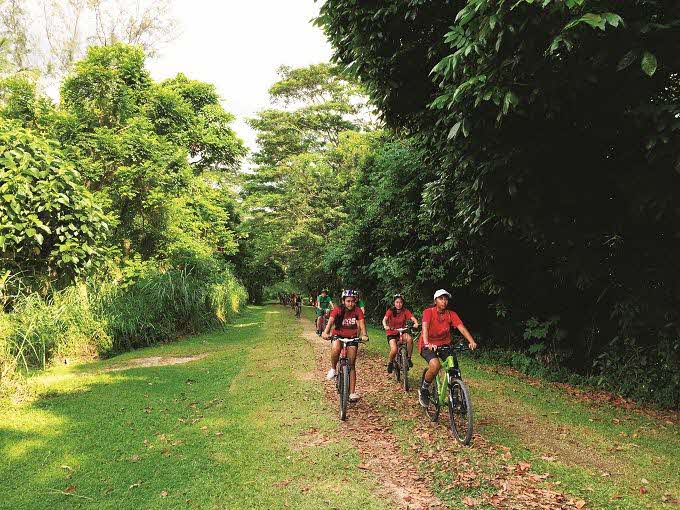
Source: URA
The Rail Corridor is very long, covering a distance of 24 km and across the entire width of the country. This makes the Rail Corridor unique: there is no other extensive community space in the world that connects communities across a nation from end to end.
It is estimated that 1 million people live within 1 km of the Rail Corridor in public housing estates, condominiums and landed private housing. There are also work places providing jobs and amenities adjacent to the Rail Corridor. These include offices, retail areas, business parks, industrial estates, a hospital, schools and other educational institutions. When the train was running, the railway was a barrier that divided and separated these communities from each other. With the freeing up of the railway land, there is now an opportunity to link up communities across the island.
Beyond its obvious ecological value as a green corridor, the Rail Corridor could function as a multi-use recreational corridor that is integrated with the life and urban fabric of the surrounding communities. Where the Rail Corridor runs next to lands that have yet to be developed, the Corridor could be developed and integrated with adjacent uses in creative ways that optimise land use while preserving its seamless connectivity, heritage and special green identity.
As a community space that threads through the nation, ample room could be set aside for people to participate in various community activities, sports and the arts—it is a unique public space for people from all walks of life to enjoy and develop shared experiences and memories. In the process, the Rail Corridor can help foster a sense of community, strengthen social bonds and resilience, and enhance communal well-being.
It has been important for URA to work with the community to develop a shared vision for the Rail Corridor. This effort will guide the establishment of appropriate design goals and the formulation of a robust and comprehensive Master Plan for the Rail Corridor—striking a balance between meeting the public’s aspirations to retain the green character and heritage of the Rail Corridor, while allowing part of it to be sensitively developed.
The Public Engagement Journey
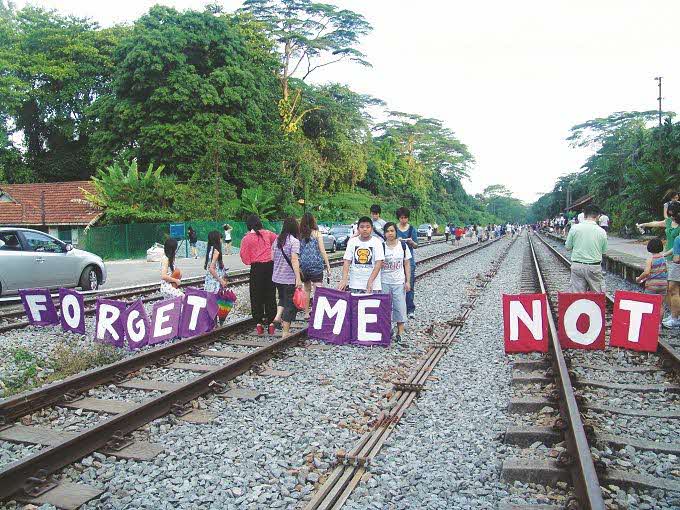
Intense public interest after the railway stopped operations.
Source: URA
Since it was announced that the railway line was to be discontinued and the land returned to Singapore, the public has shown great interest in the fate of the railway land. Fearing that the Rail Corridor would be lost to development, the Nature Society of Singapore (NSS) sent in a proposal for the preservation of the railway line as a continuous “green corridor”—the proposal enjoyed widespread support on social media.
Recognising this broad public interest, Urban Redevelopment Authority (URA) embarked on a comprehensive community engagement exercise to reach as wide a segment of the population as possible, before drawing up plans. The approach was both broad-based and targeted, with the aim to develop a shared vision and a set of planning and design goals to guide the future development of the Rail Corridor.
A variety of platforms were used to reach out to the public, including community walks, visioning workshops, design charrettes as well as public exhibitions and an online portal. “Journey of Possibilities”, an Ideas Competition for the Rail Corridor that was open to the public, was held in 2011–2012. In 2015, URA launched a Request for Proposal (RFP) to develop a Concept Master Plan and Concept Proposals for the Rail Corridor.
Rail Corridor Partnership
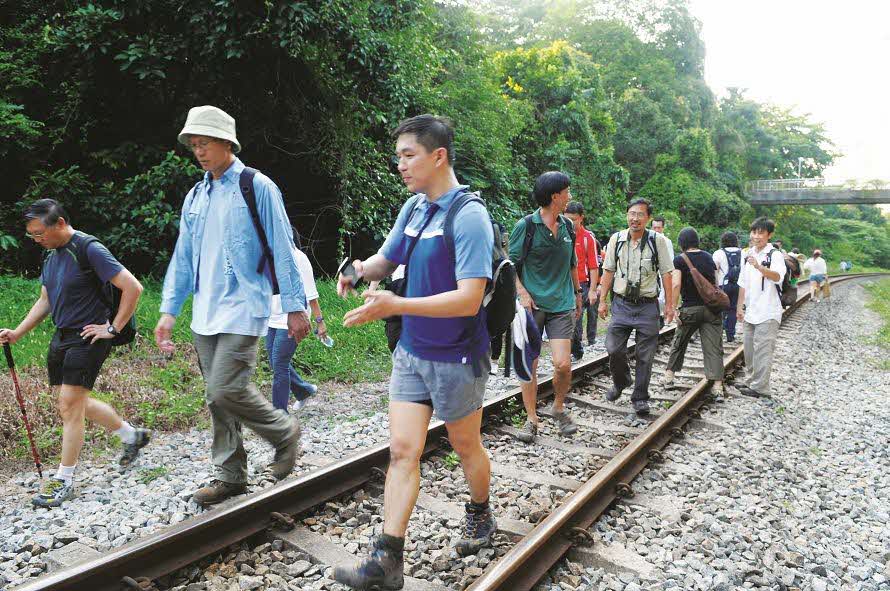
Then Minister of State for National Development Tan Chuan-Jin walking the Rail Corridor with RCP members.
Source: URA
A significant first step in community engagement was the formation in July 2011 of the Rail Corridor Consultation Group (RCCG).
An informal people-government partnership to seek views from experts as well as those who were passionate about the Rail Corridor, the RCCG was helmed by then Minister of State for National Development Tan Chuan-Jin. RCCG participants included members of interest groups such as the Nature Society of Singapore (NSS), the Singapore Heritage Society (SHS),the founder of “We Support the Green Corridor” Facebook page, founding members of the “Friends of the Green Corridor”, a popular blogger on heritage issues, an avid cyclist, academics in environmental sciences and conservation and an architect who is an authority on butterflies.
The RCCG was crucial in providing well-informed feedback and suggestions to the URA, in charting the development plans for the Rail Corridor. It helped to review ideas and proposals from the public and advised the URA on how to make its public engagement more effective. The RCCG’s role was subsequently expanded to support public interest in uses of the Rail Corridor for community-related activities and events, for which public input could be incorporated with theCorridor’s design specifications. To this end, RCCG membership was expanded and it was renamed the Rail Corridor Partnership (RCP).
Rail Corridor Communication & Feedback Portal
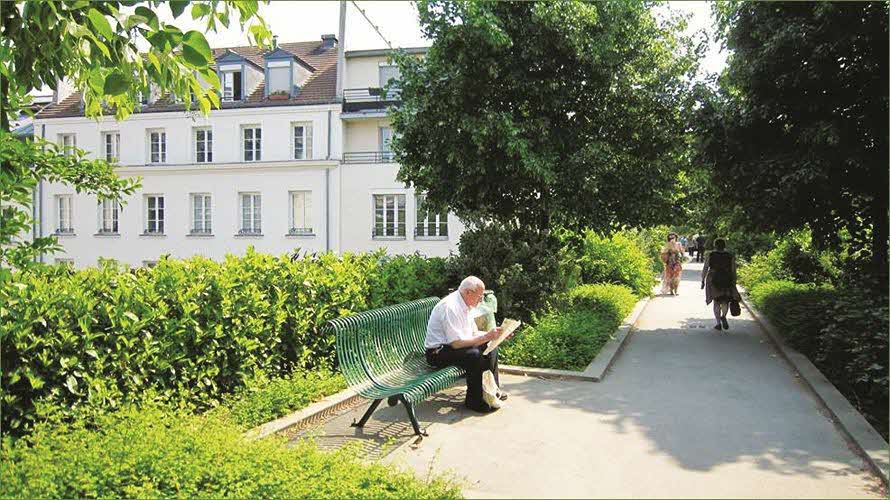
Built atop a disused railway line in the east of Paris, the Promenade Plantée is a linear park spanning 4.7 km.
Source: URA
Leveraging widespread online interest in the Rail Corridor, the URA launched a dedicated Rail Corridor website offering historical information on the railway line, walking maps of the Rail Corridor and timing of infrastructureworks affecting the Corridor. It also featured overseas examples of other disused railway corridors that have been re-purposed into well-loved community spaces in their respective cities, such as the Promenade Plantée in Paris and the High Line in New York.
The website became an avenue for the public to post their personal photographs and memories of the railway line and an online forum allowed the public to post ideas for the Rail Corridor, as well as comment on and vote on these ideas. This provided URA with a good overall sense of what people value and the attributes and features they would like to see at the Rail Corridor.
Community Visioning Workshops & Exhibitions
Friends of the Green Corridor was an early civil society group formed to discuss the future of the Rail Corridor. The group was invited to hold its community visioning workshop on URA premises. The outcomes were later showcased as “Re-imagining the Rail Corridor”, a public exhibition at the URA City Gallery.
URA also reached out extensively to youths in Singapore, as the future beneficiaries of the Rail Corridor plan. Tertiary education institutions were invited to embrace the Rail Corridor as part of their design curriculum. Close to 2,000 students, including many from secondary schools near the Rail Corridor, took part in hands-on workshops, site visits and lectures. Some of these students would later become passionate ambassadors, leading guided walks along the Rail Corridor.
Open and Youth Ideas Competition
Public feedback made it clear that many more people wanted to contribute in a more tangible way towards the future plans for the Rail Corridor. Between 2011 and 2012, URA held an Ideas Competition titled “Journey of Possibilities” for the public to propose innovative solutions and ideas through the use of drawings, sketches and diagrams. These were based on five themes that had surfaced as key challenges for the Rail Corridor:
- Biodiversity and Sensitive Development
- Inclusiveness, Accessibility and Resolving Use Conflicts
- Community Ownership, Pride and Sense of Well-being
- Celebrating Heritage
- Extraordinary Ideas for a Public Space
The competition also featured a Youth Challenge: young participants from schools were encouraged to come up with new ideas and proposals that would surprise and excite Singaporeans. Thiswas to reflect the interests and aspirations of the younger generation, and how the Rail Corridor could be especially meaningful to them.
URA received more than 200 submissions in total. Apart from professionals such as landscape architects, the competition attracted interest from local schools and tertiary education institutions. It also attracted overseas submissions from Australia, the United Kingdom, Denmark, the Netherlands and the United States. The ideas and proposals were exhibited at the URA City Gallery and the winners were invited to present their proposals in a public seminar.
Engaging with Community Partners
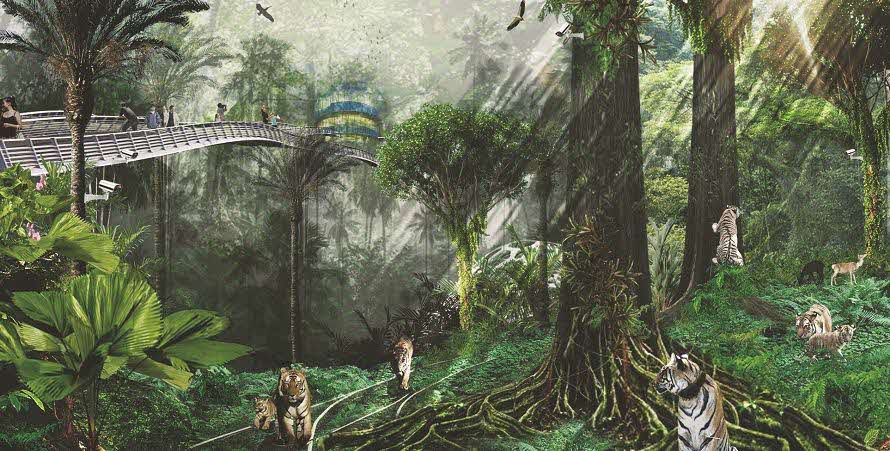
Journey of Possibilities winning entry: Tiger’s Garden by Oculous
Source: URA
URA worked with community partners to establish specific user requirements that could be incorporated into the future design and Master Plan of the Rail Corridor. Various events and activities were considered for the use of the trail as well as the defunct Tanjong Pagar Railway Station. While the objective was to discover the practical constraints and challenges of using the Rail Corridor for community activities, it was also an opportunity to expose more local residents to the Rail Corridor first-hand.
URA also reached out to private sporting and event management companies to make use of the Rail Corridor, which led to the inaugural Green Corridor Run in 2013. This cross-country run covered half the length of the Rail Corridor starting from Tanjong Pagar Railway Station and ending at the Bukit Timah Railway Station. The event attracted more than 6,000 runners who had to be flagged off in three waves. In subsequent years, the Green Corridor Run attracted even larger number of participants. From observing these events, URA was able to assess what facilities were needed for community events to be held at the Rail Corridor in future. For instance, large-scale events such as the Green Corridor Run required big staging areas at the start and end-points to hold participants and spectators, with areas for bag collection, refreshment points, pop-up kiosks, a first aid post, service vehicle drop-offs and parking for logistical purposes. Such learning experiences informed the desired outcomes and requirements incorporated in the subsequent Request for Proposal (RFP) Design Brief for the Rail Corridor.
To ensure that the former Tanjong Pagar Railway Station was put to good interim uses, the Singapore Land Authority (SLA) rented out the building for a range of short-term uses, including a fashion runway show, art exhibitions, performances, flea markets, Heritage Week events and school activities. The popularity of many of these events with the public made a case for the building to be re-purposed for various multi-function and community-related uses in future.
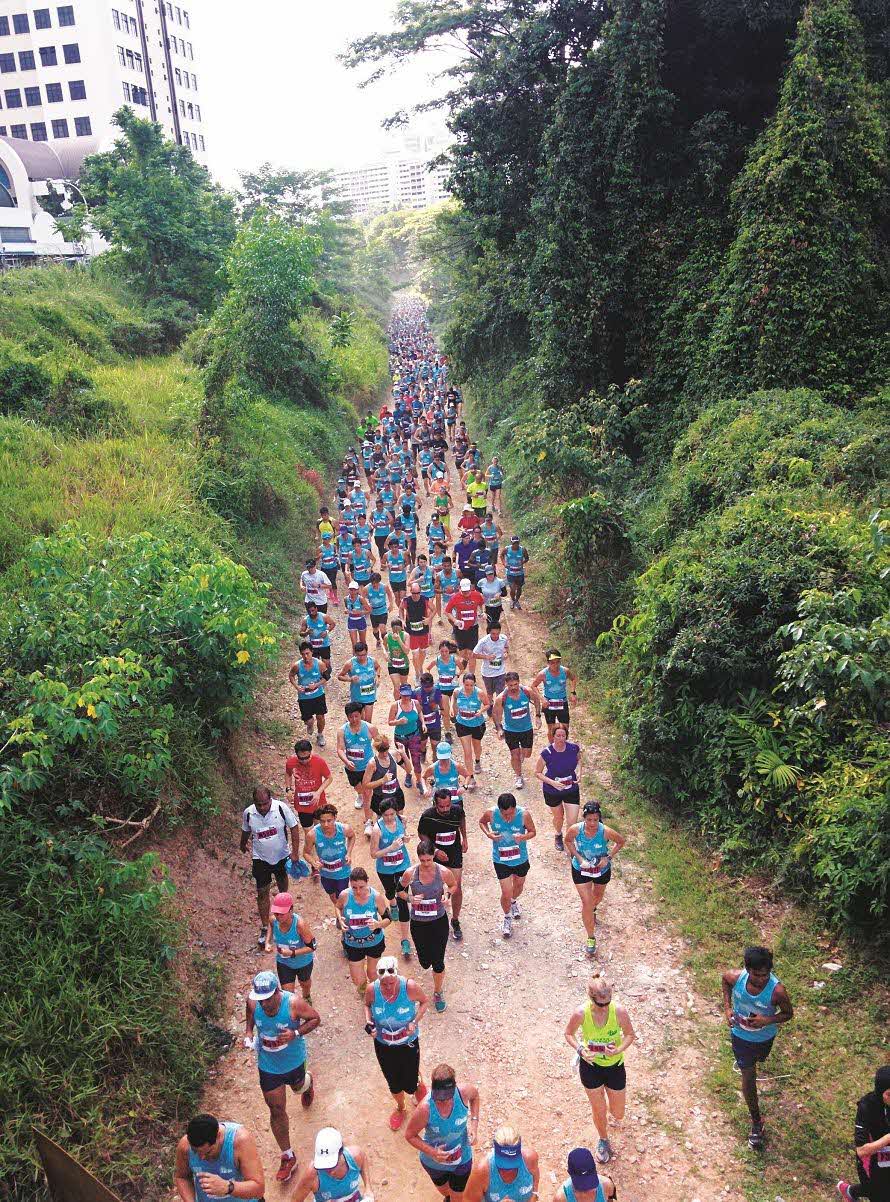
2015 Green Corridor Run
Source: URA
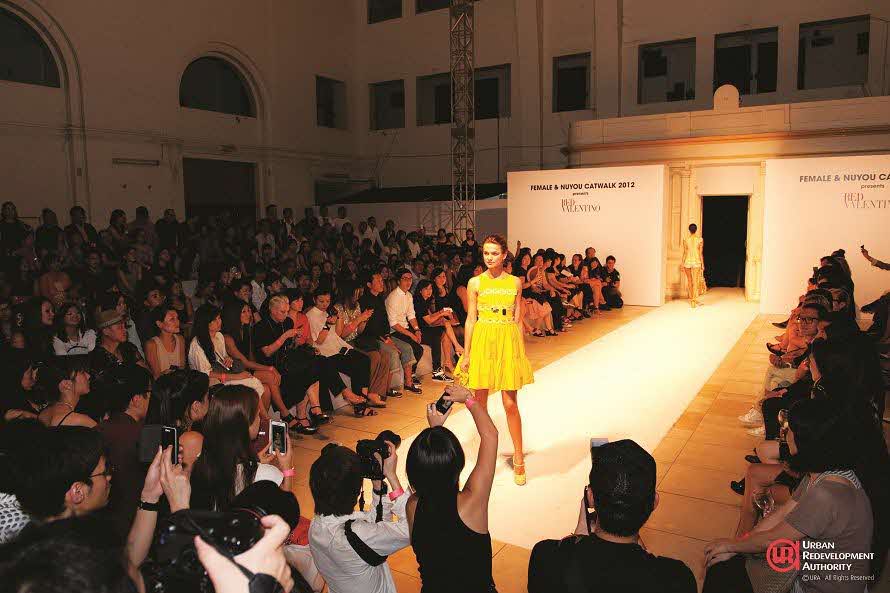
A fashion show at the Tanjong Pagar Railway Station in 2012.
Source: URA
URA, with the National Arts Council, engaged a local street artist collective to enhance a section of the Rail Corridor underneath Commonwealth Avenue West viaduct. This was to test-bed part of the Rail Corridor as an inclusive arts destination, channelling creative energy into the “right place” along the Corridor. The ArtSpace@Rail Corridor became a successful model of collaboration, with a group of community partners and artists taking co-ownership and responsibility for managing a covered part of the Rail Corridor as a unique and interactive arts venue. It became so popular that it hosted a renown international street art festival called the Meeting of Styles in 2014. Street jams turned the ArtSpace into a lively art and music event venue at night (Noise Festival) in 2015 and 2016. These successful outcomes from working with a self-regulating artist community helped anchor the idea that the arts could become one of the permanent features of the Rail Corridor in future.
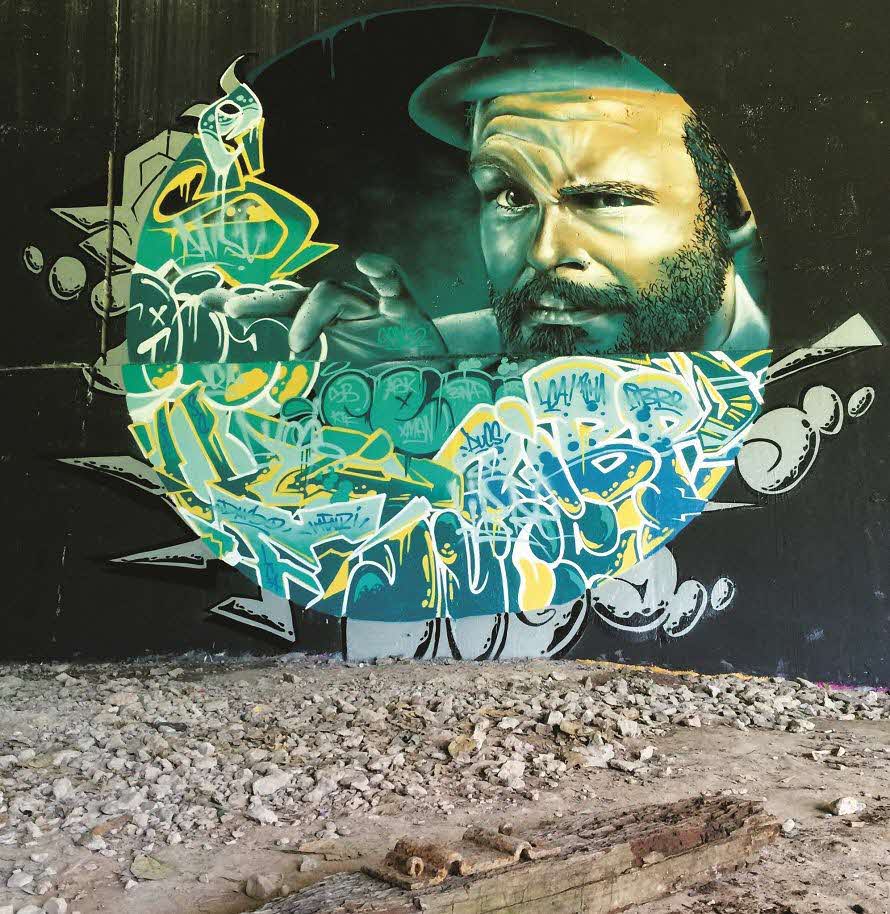

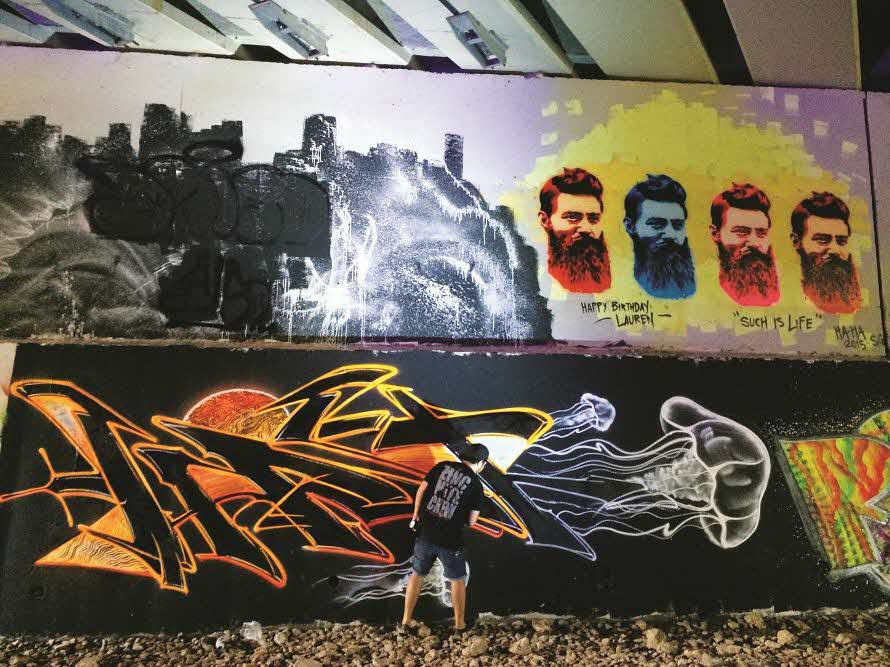
Street art events—ArtSpace@Rail Corridor
Source: URA
Shared Vision:
9 Planning and Design Goals
Engaging the public and working with community partners brought new perspectives on how the Rail Corridor could be developed into an endearing and inclusive community space. From the values and aspirations shared by the public, URA distilled a set of Planning and Design Goals, reflecting a shared vision for the Rail Corridor. These goals were incorporated into the design brief to guide the conceptualisation and design of the Rail Corridor:
- Retain the Green Corridor Identity
- Establish Seamless Connectivity
- Enhance Bio-diversity and Ecology
- Celebrate Sense of Place and Memories
- Develop Inclusive and Safe Space
- Promote Leisure and Spirit of Discovery
- Foster Community Ownership and Stewardship
- Encourage Healthy Lifestyle
- Create Innovative Design Solutions for Urban Integration
Request for Proposal (RFP) for the Rail Corridor

Source: Nikken Sekkei
In March 2015, URA launched the RFP to develop a Concept Master Plan and Concept Proposals for the Rail Corridor. It sought design solutions and desired outcomes that were consistent with the aspirations that both government and the public had for the future of the Rail Corridor.
The RFP called for the transformation of the Rail Corridor into an “Inspired and Extraordinary Community Space”. It included concept designs for a number of key activity nodes, smaller community nodes, and plans for the adaptive re-use of the Tanjong Pagar Railway Station into a multi-functional community building and anchor node for the Rail Corridor.
The RFP also called for innovative design typologies and creative concepts to integrate a new housing precinct with the Rail Corridor, while enhancing the latter’s green identity and user experience. The concept for this housing site should also demonstrate how the Rail Corridor, together with adjacent elements of greenery and water, could be integrated in a comprehensive design that would serve as a future model for sustainable high quality affordable housing in other similar green settings. Two of the RCP members were invited to join the team of local and international experts on the jury panel for the RFP.
In November 2015, Nikken Sekkei won for its proposal for the 24 km Rail Corridor Concept Master Plan; MKPL Architects and Turenscape won for its Concept Proposals for the adaptive re-use of Tanjong Pagar Railway Station and the new housing precinct.
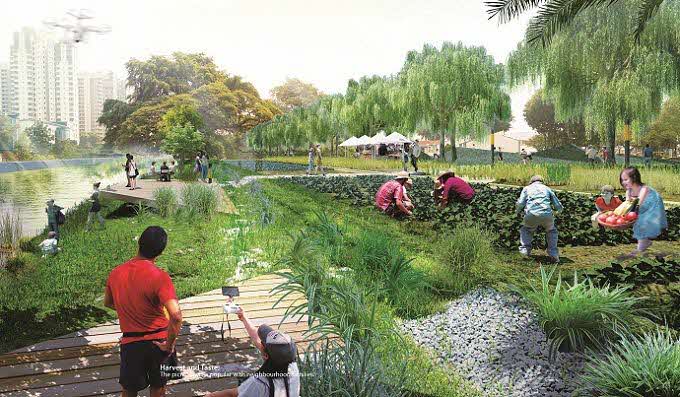
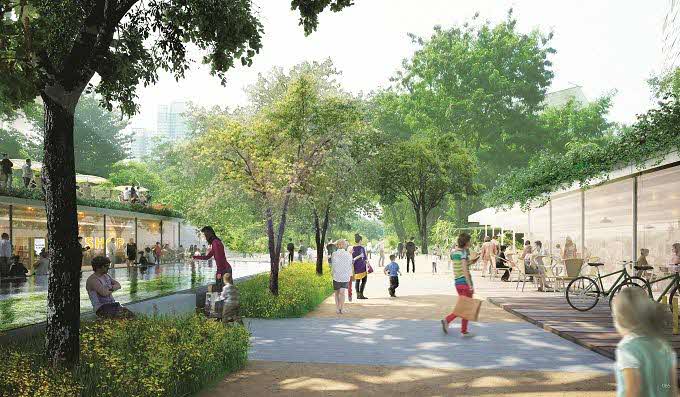
Trail and nodes in the winning proposal for the 24 km Rail Corridor Concept Master Plan
Source: Nikken Sekkei
The winning proposals were exhibited at the URA City Gallery for public feedback. In addition, URA took a further step in public engagement by bringing the highlights of the exhibition to seven community centres near the Rail Corridor so that residents who live closest to the Corridor could also offer their views. These roving exhibitions were accompanied by a series of community workshops held in 2016 that targeted different groups of residents, including seniors, families with young children and the physically challenged.
Public inputs from the exhibitions and workshops were used to refine the Concept Master Plan1 and Concept Proposals and to develop the Preliminary Design for the 4 km “signature stretch” of the Rail Corridor at Bukit Timah Railway Station—identified as the first stage of the Rail Corridor—to be completed in 2019. The rest of the Rail Corridor trail will largely be developed by 2021.
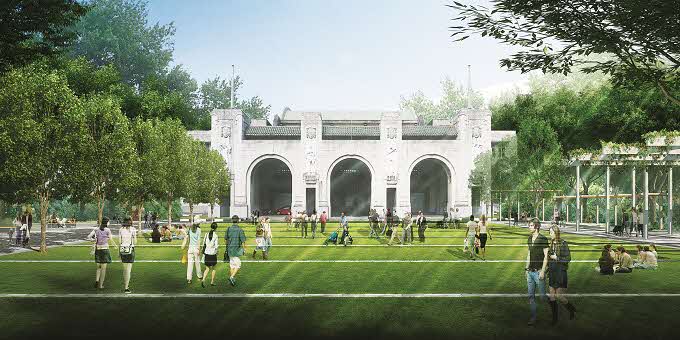
Source: MKPL Architects & Turenscape
Rail Corridor Co-creation as Social Infrastructure
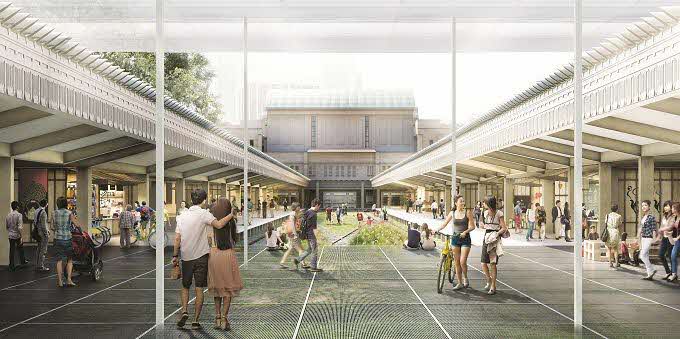

Concept proposals for the adaptive re-use of Tanjong Pagar Railway Station
Source: MKPL Architects & Turenscape
The future plans for the Rail Corridor will impact many people’s lives, by virtue of the fact that it spans the entire width of the country. From the onset, URA sought to develop a robust plan for the Rail Corridor that is able to meet most people’s aspirations, while making sure that land use is optimised. With optimal land use, not only can the Rail Corridor be retained and enhanced but more people will be able to enjoy its intrinsic attractiveness, unique greenery and rich heritage. The Rail Corridor will create a new space identity that gives urban residents the sensations of nature in the heart of the city. The future of the Rail Corridor had to be visionary, sensitive and pragmatic at the same time.
To ensure that the plan would be relevant to the community, it was important to first find out what people valued most about the Rail Corridor and what their own aspirations for the future of this very special place were. URA wanted to co-create the future of the Rail Corridor with the public.
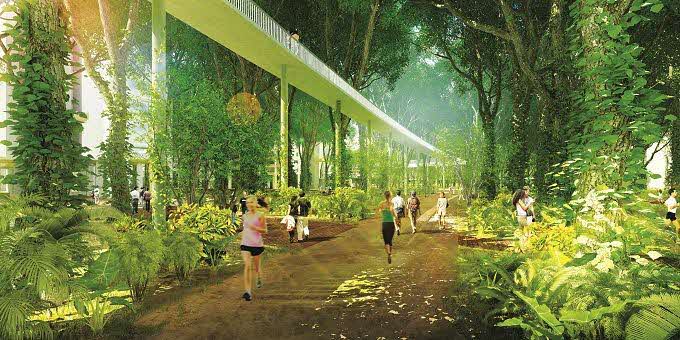
Source: MKPL Architects & Turenscape
URA began by touching base with stakeholder groups representing nature and heritage interests, as they were the first to provide feedback and suggestions to the government. But sensing that the “silent majority” of Singaporeans may not have been exposed to the Rail Corridor, and there could be different voices and opinions about the shaping of this space in future, URA decided to reach out to the wider community for inputs, particularly those living near the corridor.
From the beginning, it was clearly recognised that there are no set formulas to be used in the planning and design of this space given its special nature, and the government should seek the best ideas for the site. Guided by the overarching planning goals and design principles formulated from public feedback, URA was able to demonstrate that with creativity and sensitive design, the planning objectives of optimal land use could be balanced with aspirations to preserve the Rail Corridor as a unique green corridor and transform it into an extraordinary community space.
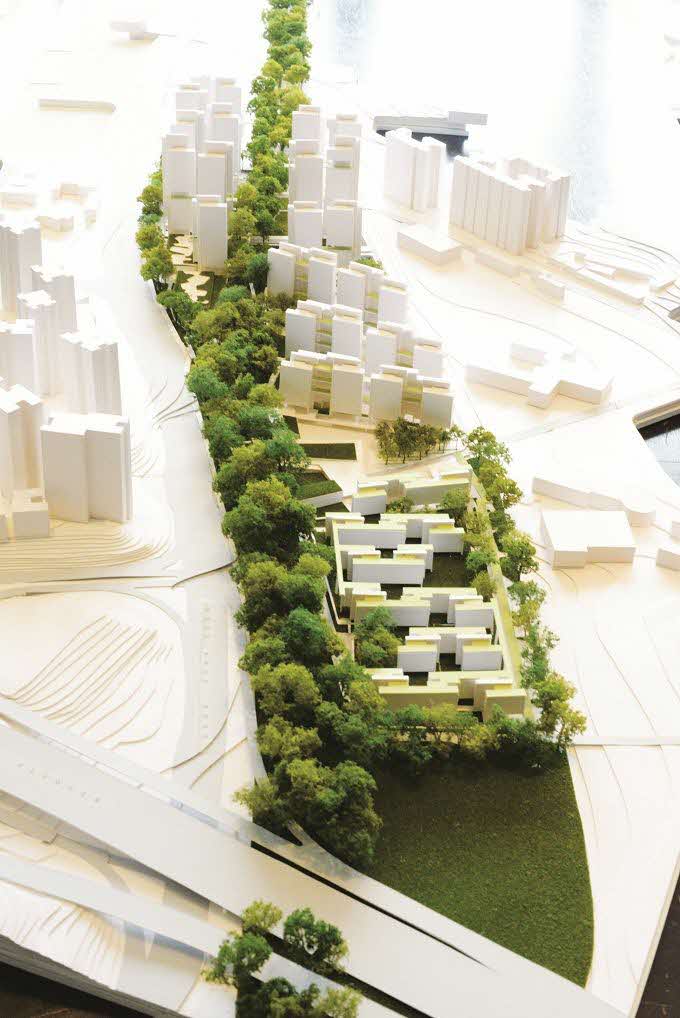
Concept proposal for housing precinct integration with the Rail Corridor
Source: MKPL Architects & Turenscape
The government did not just take a proactive role in engaging the community. URA was driven to match the passion and deep seated interests from civil society, built trust with stakeholders, and together develop a shared vision for the Rail Corridor. Throughout this process, URA as the land use planning authority needed to lead with vision, initiate actions and carry out plans with the support and advice of an equally committed Rail Corridor Partnership. The Partnership became a trusted and constructive “sounding board” for URA to test out ideas and seek views on proposals before going public. At times, they helped clarify URA’s views to the public.

Source: MKPL Architects & Turenscape
Community engagement goes beyond simply soliciting feedback and ideas from the public to inform the project. By nurturing community interest, URA also hopes to build up stewards that will look after the Rail Corridor in future.
Beyond its physical form as a linear green space, the Rail Corridor plays a unique role as a piece of social infrastructure with the potential to bring people together.
The focus of public engagement for the Rail Corridor was “co-creation”, with the government working closely with stakeholders and the community from the onset to achieve consensus on a shared vision and desired outcomes for the Rail Corridor. This contrasts with the government seeking buy-in or acceptance from stakeholders after plans have already been formulated.
For the Rail Corridor, co-creation was an important approach: beyond its physical form as a linear green space, the Rail Corridor plays a unique role as a piece of social infrastructure with the potential to bring people together. It socialises the community by creating a common space for people to develop shared experiences and memories and form community relationships with each other.
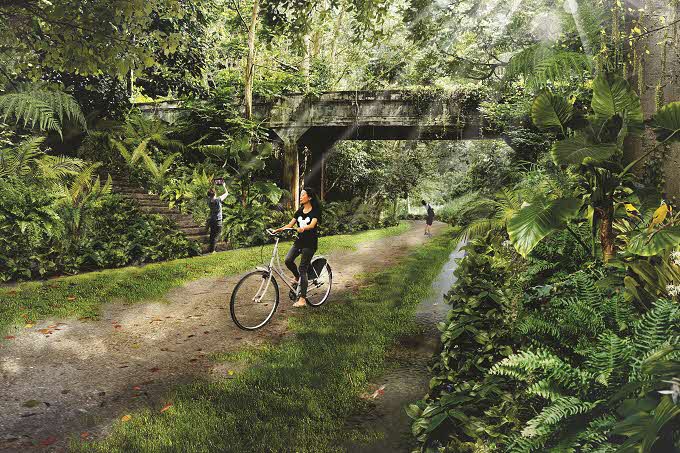
Artist’s impression of the “4 km signature stretch”
Source: URA
If the Rail Corridor is planned well, developed and programmed properly, it will become not just a green haven and a leisure corridor, but a shared space for community bonding and social integration for people from all walks of life. Open spaces like the Rail Corridor are great social levellers—anyone and everyone can enjoy it. With a connection to nature running through the heart of our urban city-state, this project will improve the quality of life for all residents. It fosters a strong sense of community ownership, civic engagement and pride which will support its sustainability as a public space. Ultimately, it is our hope that the transformed Rail Corridor will be frequently visited and loved by the community and be a source of inspiration and national pride that holds a special place in the hearts of all Singaporeans.
NOTES
- The Concept Master Plan for the Rail Corridor won two awards for URA and the Nikken Sekkei Design Team: the UK Landscape Institute 2017 Award for Urban Design and Master Planning, and the International Federation of Landscape Architects (IFLA) 2017 Asia Pacific Region “Outstanding Award” for Analysis and Master Planning.

